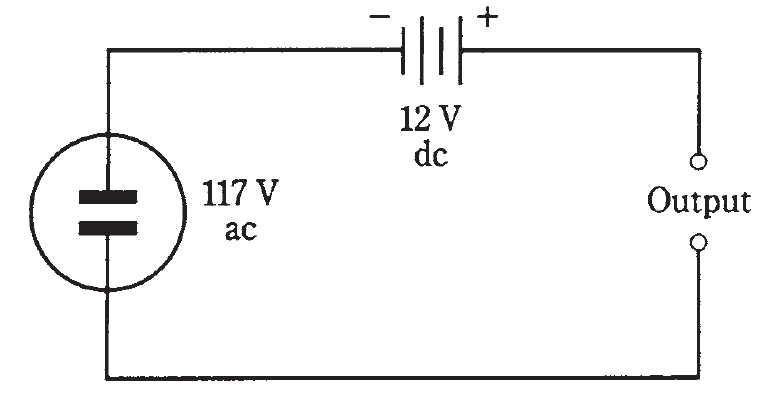


 الفيزياء الكلاسيكية
الفيزياء الكلاسيكية
 الكهربائية والمغناطيسية
الكهربائية والمغناطيسية
 علم البصريات
علم البصريات
 الفيزياء الحديثة
الفيزياء الحديثة
 النظرية النسبية
النظرية النسبية
 الفيزياء النووية
الفيزياء النووية
 فيزياء الحالة الصلبة
فيزياء الحالة الصلبة
 الليزر
الليزر
 علم الفلك
علم الفلك
 المجموعة الشمسية
المجموعة الشمسية
 الطاقة البديلة
الطاقة البديلة
 الفيزياء والعلوم الأخرى
الفيزياء والعلوم الأخرى
 مواضيع عامة في الفيزياء
مواضيع عامة في الفيزياء|
Read More
Date: 29-4-2021
Date: 1-4-2021
Date: 7-4-2021
|
Superimposed direct current
Sometimes a wave can have components of both ac and dc. The simplest example of an ac/dc combination is illustrated by the connection of a dc source, such as a battery, in series with an ac source, like the utility mains. An example is shown in the schematic diagram of Fig. 1. Imagine connecting a 12-V automotive battery in series with the wall outlet. (Do not try this experiment in real life!) Then the ac wave will be displaced either positively or negatively by 12 V, depending on the polarity of the battery. This will result in a sine wave at the output, but one peak will be 24 V (twice the battery voltage) more than the other.
Any ac wave can have dc components along with it. If the dc component exceeds the peak value of the ac wave, then fluctuating, or pulsating, dc will result. This would happen, for example, if a 200-Vdc source were connected in series with the utility output. Pulsating dc would appear, with an average value of 200 V but with instantaneous values much higher and lower. The waveshape in this case is illustrated by Fig. 2.

Fig. 1: Connection of a dc source in series with an ac source.

Fig. 2: Waveform resulting from 117 Vac in series with + 200 Vdc.
“Hybrid” ac/dc combinations are not often generated deliberately. But such waveforms are sometimes seen at certain points in electronic circuitry.



|
|
|
|
علامات بسيطة في جسدك قد تنذر بمرض "قاتل"
|
|
|
|
|
|
|
أول صور ثلاثية الأبعاد للغدة الزعترية البشرية
|
|
|
|
|
|
|
مكتبة أمّ البنين النسويّة تصدر العدد 212 من مجلّة رياض الزهراء (عليها السلام)
|
|
|